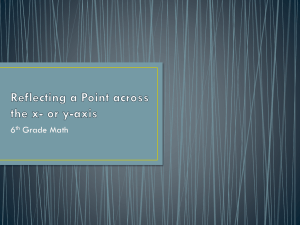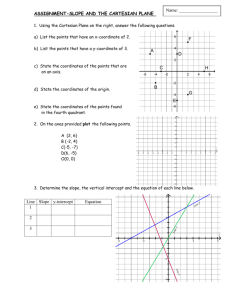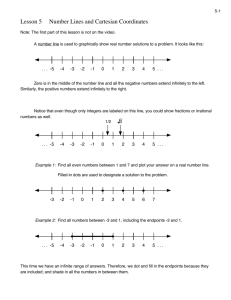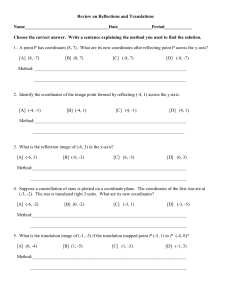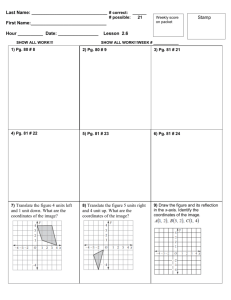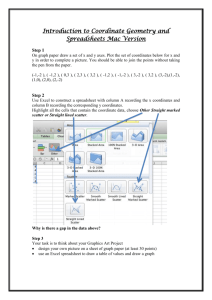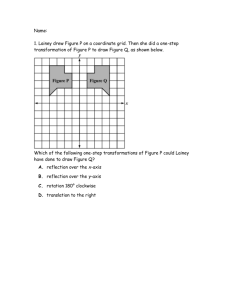Transformations on the coordinate plane
advertisement
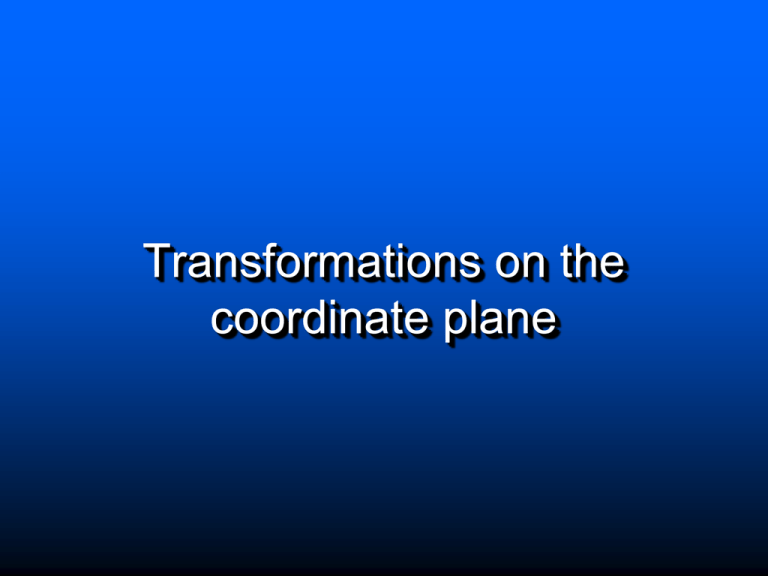
Transformations on the coordinate plane Transformations Review Type A translation moves a figure left, right, up, or down A reflection moves a figure across its line of reflection to create its mirror image. A rotation moves a figure around a given point. Diagram Now we will look at how each transformation looks on a coordinate plane. The transformed figure is often named with the same letters, but adding an apostrophe. The transformation of ABC is A’B’C’. Translation Translate ABC 6 units to the right. Find point A and count 6 units to the right. Plot point A’. Find point B and count 6 units to the right. Plot point B’. Find point C and count 6 units to the right. Plot point C’. 6 Units A A’ B’ B C C’ Translation Rules •To translate a figure a units to the right, increase the x-coordinate of each point by a amount. •To translate a figure to the left,right. Translate point P (3,a2)units 9 units to the decrease each Since we the arex-coordinate going to the of right, wepoint add by 9 toa amount. the x-coordinate. 3 + 9 = 12, so the new Translate point P (3, units coordinates of 2) P’ 6are (12,to2)the left. Since we are going up, we subtract 6 to the xcoordinate. 3 - 6 = -3, so the new coordinates of P’ are (-3, 2) Translation Rules •To translate a figure a units up, increase the y-coordinate of each point by a amount. •To translate a figure a (3, units Translate point P 2) down, 9 unitsdecrease up. the y-coordinate of each by 9a to amount. Since we are going up, point we add the yTranslate point P 9(3,= 2) units coordinate. 2+ 11,6so thedown. new Since we coordinates are going down, of P’ we aresubtract (3, 11) 6 to the y-coordinate. 2 - 6 = -4, so the new coordinates of P’ are (3, -4) Translation Example 2 The coordinates of Since we are -5 + 6 = 1, so the point A are (-5, 4) moving to the right new coordinates we increase the x- of A’ are (1, 4). coordinate by 6. The coordinates of Since we are -2 + 6 = 4, so the point B are (-2, 3) moving to the right new coordinates we increase the x- of B’ are (4, 3). coordinate by 6. The coordinates of Since we are -3 + 6 = 3, so the point C are (-3, 1) moving to the right new coordinates we increase the x- of C’ are (3, 1). coordinate by 6. Practice • Point P (5, 8). Translate 2 to the left and 6 up. P’ (3, 14) • Point Z (-3, -6). Translate 5 to the right and 9 down. Z’ (2, -15) • Translate LMN, whose coordinates are (3, 6), (5, 9), and (7, 12), 9 units left and 14 units up. L’M’N’ (-6, 20), (-4, 23), (-2, 26) Reflection Reflect ABC across the y-axis. Count the number of units point A is from the line of reflection. Count the same number of units on the other side and plot point A’. Count the number of units point B is from the line of reflection. Count the same number of units on the other side and plot point B’. Count the number of units point C is from the line of reflection. Count the same number of units on the other side and plot point C’. A 5 Units 5 Units 2 Units 2 Units B 3 Units C B’ 3 Units C’ A’ Reflection Rules •To reflect point (a, b) across the y-axis use the opposite of the x-coordinate and keep the y coordinate the same. P (3, across y-axis. •ToReflect reflect point (a, b) 2) across thethe x-axis keep Since we reflecting the use y-axis. the x-coordinate the across same and the Keep the y the same use the opposite of the x. opposite of the and y-coordinate (-3, Reflect point P (3, 2)2) across the x-axis. Since we reflecting across the x-axis. Keep the x the same and use the opposite of the y. (3, -2) Practice The coordinates of ABC are: (-5, 4), (-2, 3), (-3, 1) Reflect ABC across the y-axis and then reflect it across the x-axis. To reflect it across the y-axis keep the y the same and use the opposite x. The new coordinates are: (5, 4), (2, 3), (3, 1) To reflect it across the x-axis keep the x the same and use the opposite y. The new coordinates are: (5, -4), (2, -3), (3, -1) Rotation Rules •To rotate a point 90° clockwise, switch the coordinates, and then multiply the new ycoordinate by -1. •To rotate a point just multiply Rotate point P (3, 180°, 2) clockwise abouteach the origin. coordinate by rotating -1. Since we are it clockwise, we switch Rotate point P (3,(2, 2)3) clockwise about origin. the coordinates and multiply thethe new y Since wethe arenew rotating it 180°, we by -1, so coordinates aresimply (2, -3) multiply the coordinates by -1, so the new coordinates are (-3, -2). Practice • Point P (5, 8). Rotate 90° clockwise about the origin. P’ (8, -5) • Point Z (-3, -6). Rotate 180° about the origin. Z’ (-3, -6) • Rotate LMN, whose coordinates are (3, 6), (5, 9), and (7, 12), 90° clockwise about the origin. L’M’N’ (6, -3), (9, -5), (7, -12)
